The following is a reflection on the Passion in the Gospel of Mark.
For a version of the Prayers of the People based on the Christ Hymn in Philippians, suited for use on Palm Sunday, click here.

Detail of the Tomb Effigy of Elizabeth Boott Duveneck Frank Duveneck (1848–1919) Date: 1891, cast 1927. Photo by Rick Morley.
The portrayal of the Passion and Crucifixion in the Synoptics differs from the Gospel of John. In the Synoptics the Crucifixion is a moment of agony. Jesus is screaming screams of abandonment while being tortured.
In the Gospel of John, however, the Passion is a moment of glory. It’s the raising up of the Son of God for all the world to see. Even hanging on the cross, Jesus is in charge, and making plans for his mother to be cared for by the Beloved Disciple. His life isn’t ripped from him, but he “gives up” his Spirit. And, the moment of death corresponds to the sacrifice of the Paschal lambs in the Temple.
Every year we begin each Holy Week in a Palm Sunday/ Passion Sunday Liturgy which always features a Synoptic account, and every year on Good Friday we read from the account in John.
Preaching both of these accounts from their various perspectives is important – and it’s important not to conflate the two into one bland catch-all Passion.
For when the first Christians spoke of, preached on, and wrote about the death of Our Lord, they did so in different ways. Sometimes they conveyed the event as horrendous and horrific. They used language that is painful to read aloud.
And other times the first Christians spoke of his death as a fulfillment, and an opportunity for the whole world to see and know the glory of God and the all-encompassing power of His love.
It’s not that one version of the story is more ‘right’ or ‘correct’ than the other. They are both True. They are both Right.
They both need preached, and taught, and absorbed.
The Crucifixion was awful.
And it was the ultimate moment of Glory.
And, because the Passion accounts are so long, they provide ample resources for preaching and reflection.
I’d like to reflect here on Jesus as the “Son of God.” One can examine the entirety of the Gospel of Mark in many ways. It’s a kaleidoscope where something new can be seen each time you turn it. But, one can look at it as an account of the life, death and resurrection of Jesus that is bookenden between two proclamations: Jesus is the Son of God.
Mark begins his Gospel with these words:
The beginning of the Gospel of Jesus Christ, the Son of God.
One can have a lengthy Christological discussion as to what exactly “Son of God” means, what it meant, and how it relates to our understanding of Jesus being fully God and fully man.
However, Mark doesn’t have that Christological discussion. Mark is no theological tractate, full of scholarly and philosophical argument. No, when Mark wants to define “Son of God” he does so by painting a picture, albeit with words.
And, it’s a picture of crucifixion. It’s a picture of death.
After Jesus breathes his last, after his body is deflated from the Life which once occupied it—THEN is when the centurion exclaims in wonder:
Surely this man was the Son of God.
Dick Teresi is making some waves with his recently published book “The Undead,” where he questions the methods and criteria by which the scientific and the medical communities determine when someone is dead. I haven’t read the book yet, but I want to. Maybe after Easter…
Yet, when I’m in a hospital room and someone dies there is something—perhaps inadequately describable—that changes. Death casts a pall. What once was clearly alive is clearly no longer. We may stand around a casket in a funeral home and talk about how the dearly departed “looks peaceful” and “sleeping,” but when death has just come, it’s hard to use such words.
Skin tone changes. Eyes are empty. Cheeks sink.
And, when Jesus is in that very moment—when he makes the turn from tortured man to corpse—THAT’s when he is proclaimed as “Son of God.” That’s the penultimate moment. The moment when he has just been broken.
There’s something to that. I’m not sure it can be denied. It’s the death of Jesus Christ which, for Mark at least, exalts him above all creation.
Perhaps this should cause us to reflect theologically. Break out our old textbooks from Christology 101.
But, at the very least it should give us cause to sit at the foot of the cross this Holy Week. Before we break out the trumpet lillies and the white vestments—before we don the white vestments. Before then, perhaps we should sit at the feet of Jesus Christ, the corpse. The dead. The broken.
And behold the Son of God.
Perhaps that will make the discovery in the garden all the more revealing.
Pingback: The Awful Glory of the Cross – A Reflection by Rick Morley « Pastor's Postings